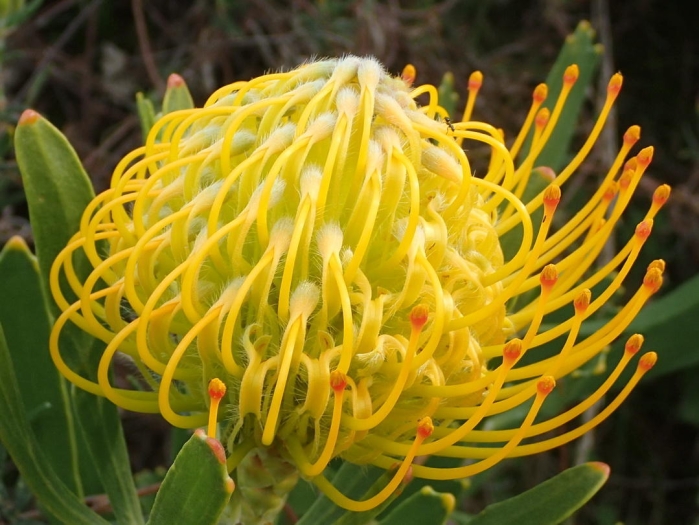Wart-Stemmed Pincushion
(Leucospermum cuneiforme)
Wart-Stemmed Pincushion (Leucospermum cuneiforme)
/
/

Nicola van Berkel
CC BY-SA 4.0
Image By:
Nicola van Berkel
Recorded By:
Copyright:
CC BY-SA 4.0
Copyright Notice:
Photo by: Nicola van Berkel | License Type: CC BY-SA 4.0 | License URL: http://creativecommons.org/licenses/by-sa/4.0/ | Rights Holder: Nicola van Berkel | Publisher: iNaturalist | Date Created: 42547 |






















































Estimated Native Range
Summary
Leucospermum cuneiforme, commonly known as Wart-Stemmed Pincushion, is an evergreen shrub native to the fynbos region, specifically the sandstone slopes and flats in the Cape of South Africa. It typically grows to a height and width of 4-6 feet (1.2-1.8 meters). The plant is characterized by its distinctive inflorescences, which resemble pincushions, and its wart-like tubercles on the stems. The flowers are a vibrant mix of yellow, orange, and red, blooming from late winter through summer, and are highly attractive to birds, especially nectar-feeding species such as sunbirds.
The Wart-Stemmed Pincushion is valued for its striking flowers, which make it a popular choice for ornamental use in gardens and as a cut flower. It thrives in full sun and requires well-drained, sandy soil with low water once established, making it suitable for xeriscaping. Gardeners should be aware of its susceptibility to fungal diseases, particularly root rot if overwatered. It is also sensitive to phosphorus, so fertilizers for native plants should be used. Cultivars like "Goldie" offer variations in flower color and form, enhancing its appeal. Despite its beauty, it is not commonly invasive when grown outside its native range, but care should be taken to prevent the spread of any non-native species.CC BY-SA 4.0
The Wart-Stemmed Pincushion is valued for its striking flowers, which make it a popular choice for ornamental use in gardens and as a cut flower. It thrives in full sun and requires well-drained, sandy soil with low water once established, making it suitable for xeriscaping. Gardeners should be aware of its susceptibility to fungal diseases, particularly root rot if overwatered. It is also sensitive to phosphorus, so fertilizers for native plants should be used. Cultivars like "Goldie" offer variations in flower color and form, enhancing its appeal. Despite its beauty, it is not commonly invasive when grown outside its native range, but care should be taken to prevent the spread of any non-native species.CC BY-SA 4.0
Plant Description
- Plant Type: Shrub
- Height: 4-6 feet
- Width: 4-6 feet
- Growth Rate: Moderate
- Flower Color: Yellow, Orange, Red
- Flowering Season: Winter, Spring, Summer
- Leaf Retention: Evergreen
Growth Requirements
- Sun: Full Sun
- Water: Low
- Drainage: Medium
Common Uses
Bee Garden, Bird Garden, Butterfly Garden, Deer Resistant, Hummingbird Garden, Low Maintenance, Showy Flowers
Natural Habitat
native to the fynbos region, specifically the sandstone slopes and flats in the Cape of South Africa
Other Names
Common Names: Kustnåldyna
Scientific Names: , Leucospermum cuneiforme, Leucospermum ellipticum, Leucospermum attenuatum, Leucadendron cuneiforme, Leucadendron attenuatum, Leucadendron ellipticum, Protea attenuata,
GBIF Accepted Name: Leucospermum cuneiforme (Burm.fil.) Rourke